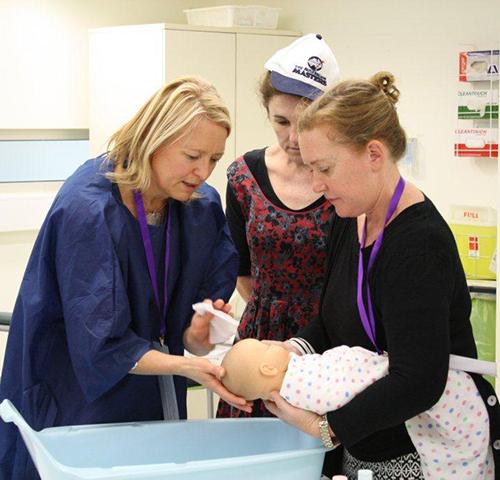First year midwifery students often struggle with the realities of the clinical setting when they attend their first placement. This project aimed to address this by giving students a taste of what they could expect when they went on placements and to begin to equip them with the confidence and skills required in the clinical setting.
Team members:
- Dr Christine Catling
- Rosemarie Hogan
- Allison Cummins
- Associate Professor Athena Sheehan
- Carolyn Hayes
What were the aims of the project?
We hoped to address two issues: the readiness of our students and the accuracy of their expectations of the realities of the clinical workplace. When first year midwifery students go on their first clinical placement they often suffer a degree of culture shock, sometimes leading them to drop out.
Also, the aspirations of midwifery students don’t always match the actual workplace experience. We developed this project to give students a taste of what they could expect when they went on clinical placements and to begin to equip them with the confidence and skills required in the clinical setting.
Previously we had undertaken smaller workshops to try to address this problem but we wanted to do something longer and more intensive. So, we developed a set of simulation scenarios that covered five stages of pregnancy and childbirth: antenatal care, birth, postnatal and neonatal care and breastfeeding.

Can you describe the project?
Simulation was part of lab work within the subject but this project introduced a two days intensive session.
Students were asked to rate their skills and confidence through a survey before and after the sessions.
Simulations were undertaken by 10 groups of 7 students. All students had the opportunity to play the parts of midwife, mother, partner or the student midwife and each role had pre-defined actions and skills to convey. We employed an actor to play the role of new mother for the neonatal care simulation.
Before the simulation the facilitator gave a briefing and a copy of the written scenario to each student in the group. Everything that happened was confidential to those within the room, this reassured students they were in a safe environment and were free to make mistakes.
Each session was set up to represent a hospital with associated props. The students rotated through each simulation, which took about an hour, including time for debriefing. The debrief was important as it allowed students to talk about their experience and for the actress playing the new mother to provide feedback.
How did it go?
From the student survey responses after the simulations and then after the clinical placements, we could see that they felt markedly more confident in their knowledge of clinical practice.
One thing that came across noticeably was the improvement in communication. Students said they learned how to say things, how to frame things, and this helped greatly when they went out on clinical placement. The clinical educators also noted that the communication of students had improved.
What did you learn?
The debrief at the end of each simulation was vital, and requires appropriate skills on the part of facilitators.
The actor was fantastic. If possible we would engage more actors as simulated patients as it provides more realism and depth to the simulations.
It was worthwhile paying to use the premium level of SurveyMonkey. It made the survey process very smooth and was easy to use.
Want to find out more?
Contact Christine Catling.

